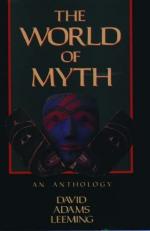
|
| Name: _________________________ | Period: ___________________ |
This test consists of 15 multiple choice questions and 5 short answer questions.
Multiple Choice Questions
1. Where is the first recorded creation myth from?
(a) Greece.
(b) India.
(c) Mesopotamia.
(d) Egypt.
2. What other divine figure does Leeming say the main Norse god resembles?
(a) Krishna.
(b) Buddha.
(c) Christ.
(d) Zeus.
3. How does Leeming describe the Boshongo culture?
(a) As matriarchal.
(b) As warlike.
(c) As communal.
(d) As patrilineal.
4. What creation myth does Leeming say modern people favor?
(a) The Big Bang.
(b) Evolution.
(c) Intelligent design.
(d) Creation ex nihilo.
5. What does Leeming say the gods function as in myth?
(a) Masks and metaphors.
(b) Mirrors.
(c) Self-portraits.
(d) Ciphers.
6. How does Leeming describe the mythic concern with creation?
(a) As a metaphor for storytelling.
(b) As a metaphor for history.
(c) As a metaphor for birth.
(d) As a metaphor for maturity.
7. What does Leeming say the Great Mother personifies?
(a) The pains of childbirth.
(b) The planet earth.
(c) Grains.
(d) The process of being born.
8. To whom does Leeming say the Egyptian god Isis corresponds in the Greek pantheon?
(a) Demeter.
(b) Athena.
(c) Persephone.
(d) Hera.
9. How does Leeming describe Hopi culture?
(a) As warlike.
(b) As patriarchal.
(c) As matrilineal.
(d) As communal.
10. When were the hieroglyphs made that contain the oldest myth Leeming cites?
(a) 1500-1200 BCE.
(b) 2200-2000 BCE.
(c) 1800-1500 BCE.
(d) 3000-2200 BCE.
11. How does Leeming say the Greek pantheon differs from other pantheons?
(a) The Greek gods were not always more powerful than humans.
(b) The Greek gods retained their local origins and cults.
(c) The Greek gods were imposed on cultures Greeks influenced.
(d) The Greek gods had a great number of human attributes.
12. What does Leeming say Horus represents, in the Egyptian pantheon?
(a) The playful nature of fate.
(b) The spiritual force governing the Pharaoh.
(c) The rage of war.
(d) The rebirth of the earth after winter.
13. What is cosmogony?
(a) Myth of the beginning of humanity.
(b) Myth of the end of time.
(c) Myth of beautification.
(d) Myth of creation.
14. What is an ontological reason for myth?
(a) To beautify existence.
(b) To understand existence.
(c) To compensate for the loss of instinct.
(d) To understand the goal of existence.
15. During whose reign was the first creation myth recorded, according to Leeming?
(a) Hatshepsut.
(b) Nebuchadnezzar.
(c) Solomon.
(d) Herod.
Short Answer Questions
1. What does Leeming say the Egyptian pantheon is centered on?
2. In Leeming's account, how did the Hopi create their creation myth?
3. What does Leeming say the flood was for in Mayan culture?
4. How does Leeming say the Zeus and Hera represented humanity in Greek culture?
5. Whose behavior does Leeming say explains the behavior of the Olympian gods in the Greek pantheon?
|
This section contains 479 words (approx. 2 pages at 300 words per page) |

|




